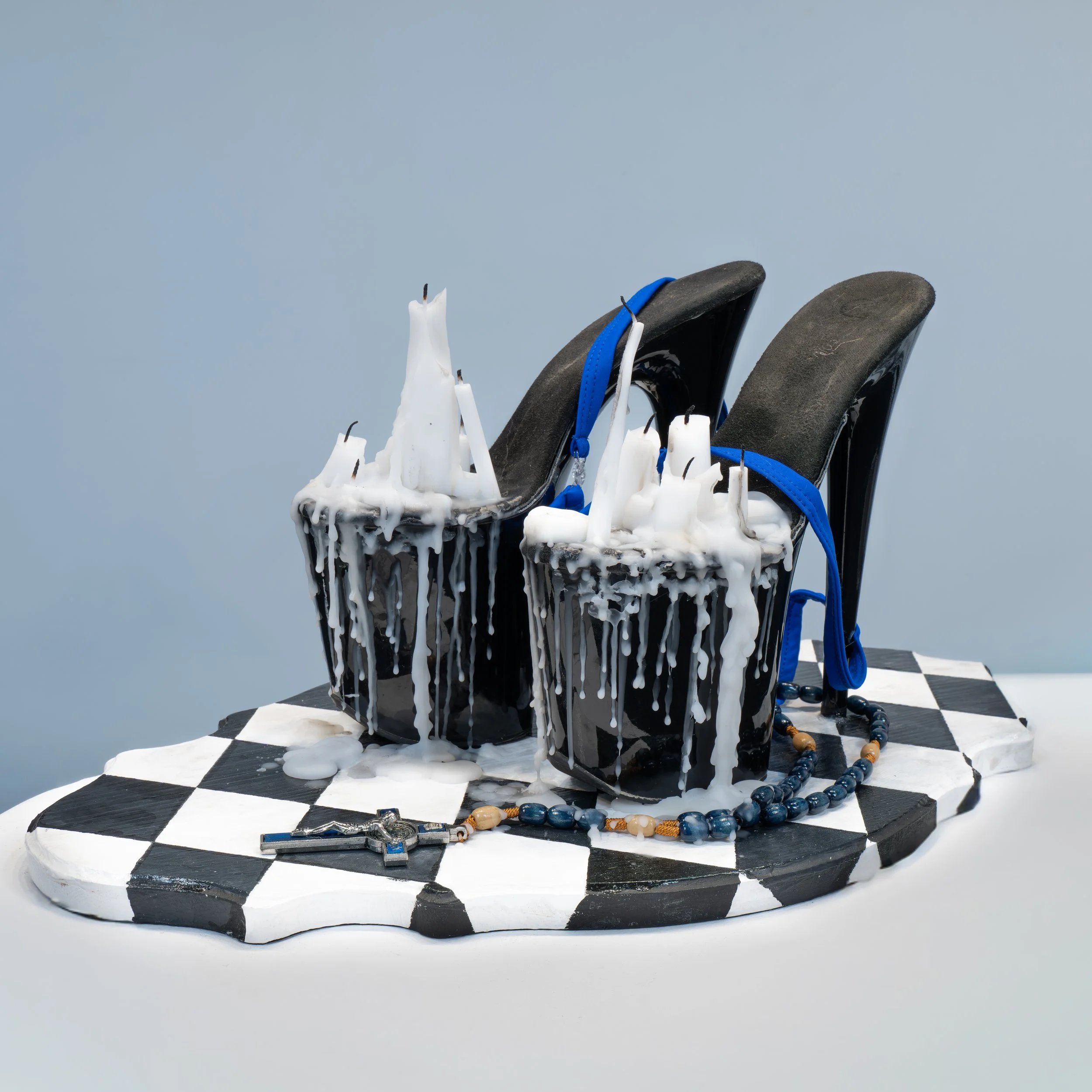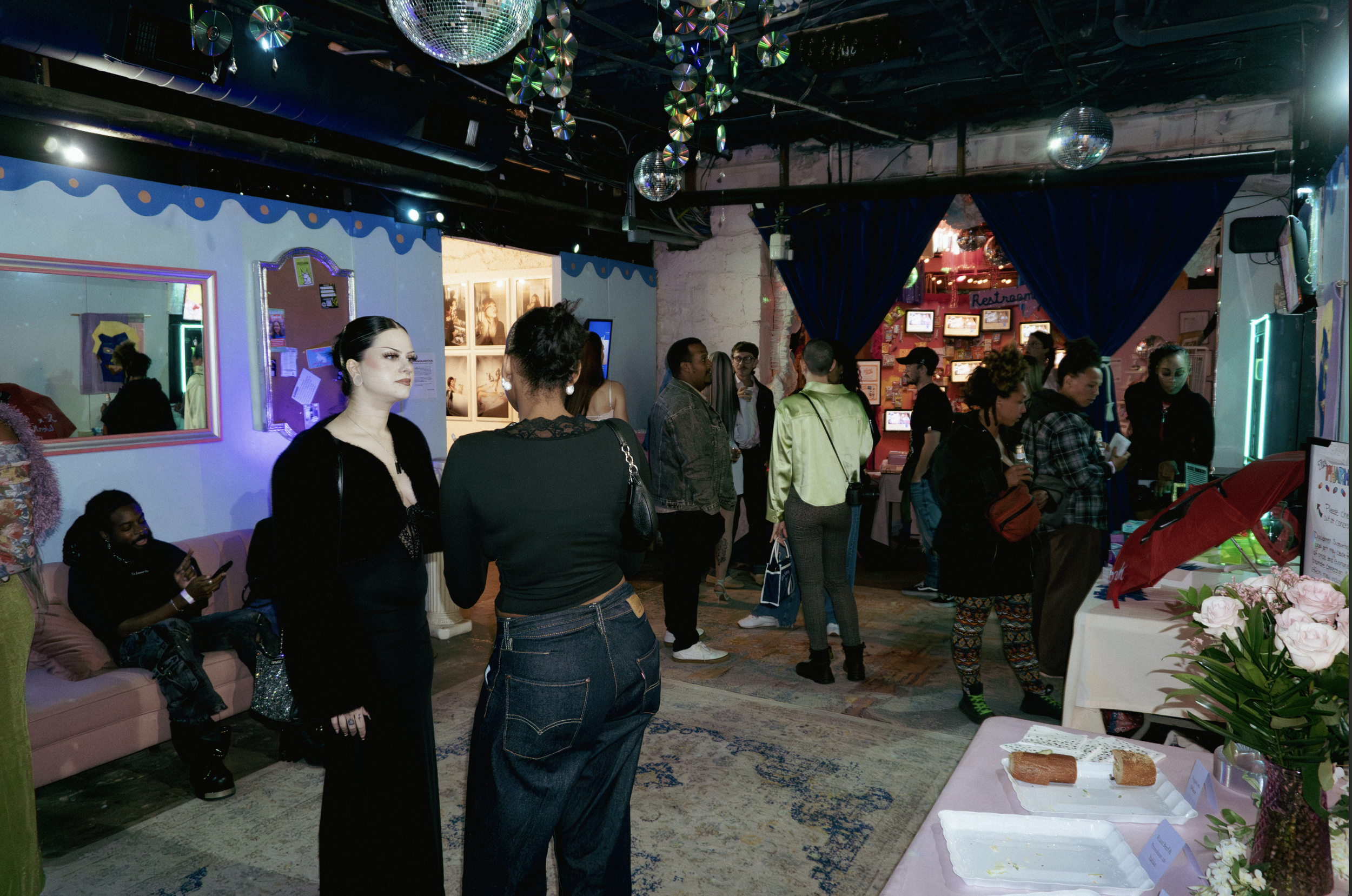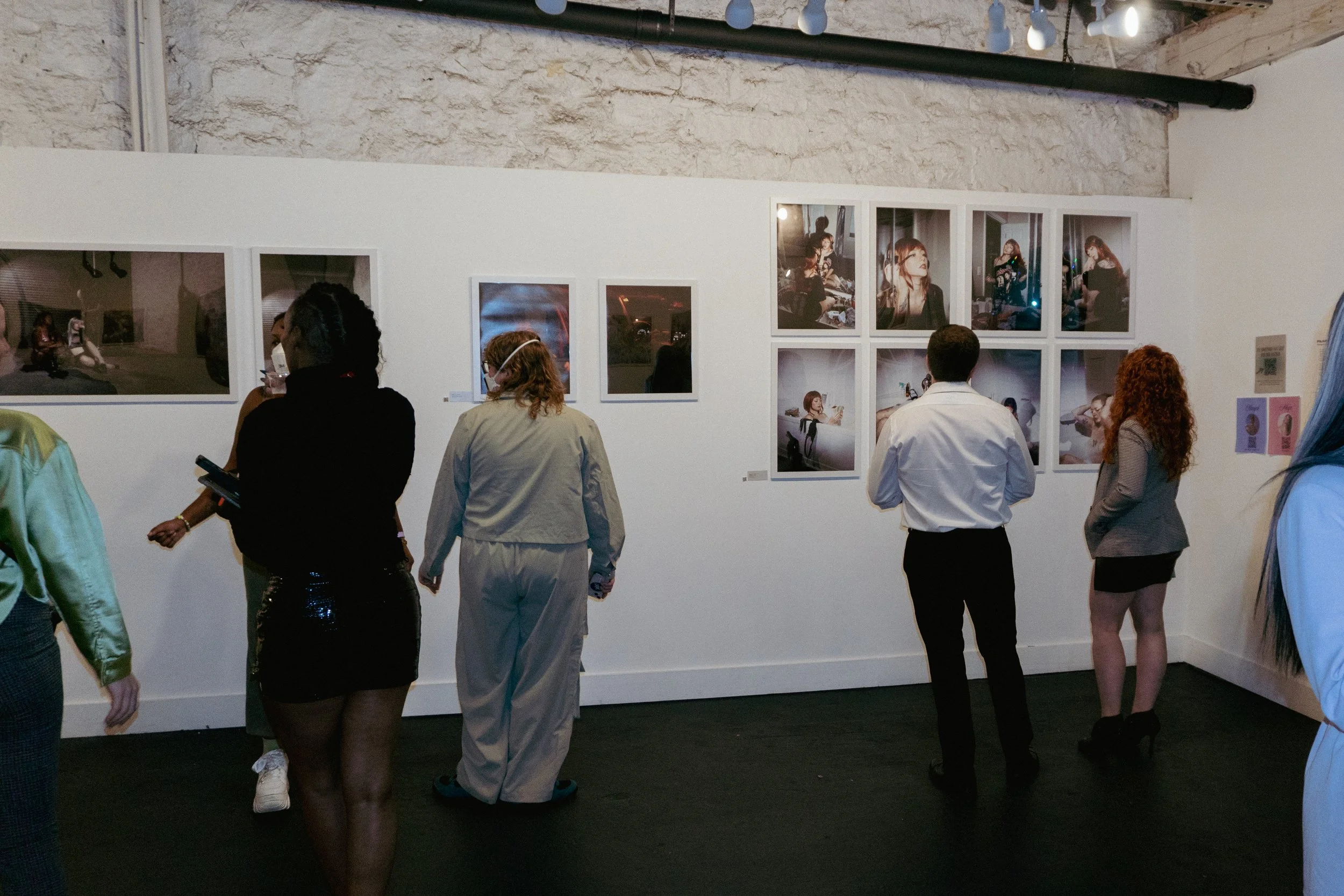Through our eyes:
Body of Work
The Art Between the Pieces
Written By River Stone
Nov 18th, 2025
Am I in the Right Place?
There’s something slightly humorous about a carefully lit gallery, with white walls and clean lines - set to energetic music, with excited conversation and a floor scattered with dollar bills.
The address said to find The Supermarket, but when you arrive you’ll find a bakery and a Big Softie. Once you make your way down a narrow hallway and down some stairs, you’re met with what feels like walking into a different, more whimsical and colorful dimension. This venue frequently accommodates all kinds of events, but people were coming in that Sunday night for a very unconventional kind of event.
Pole performers owned the center of the gallery, gracefully spinning under amber light. Guests tipped them, tipped the DJs, tipped the people working. Some people casually walked by, admiring and talking about the sculptures, photography and painting on the walls. By the pole, others eagerly threw cash in the air, letting it fall on top of the dancers while they laughed, joked, and shared . What could have felt voyeuristic instead felt like acknowledgement: a room full of people deciding that labor deserved to be seen and paid.
Margot, a curator by trade and one half of the collective behind the night, had that contradiction in mind from the show’s conception.
“I wanted the curation of the gallery to emphasize a combination of awareness, and celebration. Music filled the gallery at the hands of a sex worker, professionals stood outside to educate and gather donations, stories ranging from serious to silly were portrayed on the walls, hard-working aerialists danced for almost the entirety of the event. I wanted to show the beauty in our resilience, in awareness, and our hard work.”
Video & photography captured by Seb Se Fue
Labor Made Visible
The gallery and the collective share a name: Body of Work. That overlap is not branding, it is the thesis that acted as a catalyst for the collective's creation. The night was not put on by an institution, just two artists, their community, and whatever time and money they could carve out between everything else.
When I spoke to Megz after the show, she was sitting somewhere between gratitude and disbelief. The work behind that moment was not as glamorous as everyone looked that night.
“Pulling this event together took patience and dedication. This was mine and Margot’s first time doing anything like this, so there were a lot of things to learn, but I think it was to be expected. This experience only helped us grow as individuals and together as collaborators. We both love what we do and share a lot of the same goals, so it felt very natural working together and supporting one another through the process.”
Margot’s curatorial instinct was to make sure sex workers were not an add-on or a theme, but a centerpiece.
“I wanted to incorporate sex workers into every aspect of this event. From the subject material and education, to the entertainment, down to the music being played. I wanted everything to come from sex workers, to highlight and celebrate their versatility. I also wanted the space to feel open enough where all attendees could participate in the performances, and comfortable enough to examine and discuss the art.”
That intention showed. The room felt less like a clean separation between “art” and “entertainment,” and more like one continuous body moving in different directions.
Curating the Tension
Neatly laid out spreads of editorial photographs whose settings were mundane places like locker rooms, bathrooms, parking lots, and warehouses. A sizeable diptych that is vibrant in its color choices but subtly macabre in its subject matter when looked at more closely. Worn out stripper shoes carefully decorated with rusty nails, melted candles and colorful mushrooms.
The clash that somehow was not a clash at all: high-art presentation and cash literally flying.
Margot was explicit about wanting that friction.
“One of the main concepts that Meg and I wanted to depict was the beauty of the strip club, inside a high-art gallery; two things that most people would not put together.”
The setup was clear, but there’s always the question of how a crowd will react to an unconventional new concept. Margot was not worried about the visual coherence, but rather about how people would react to this unconventional space.
“The only aspect of this we were concerned about was not the blending of these concepts, but the blending of those in attendance. People’s behavior in art museums and strip clubs are vastly different, so we tried to form a kind of middle-ground where there was an utmost respect for the performers, the venue, and the art itself. We achieved this through advocating a semi-formal dress code (with a sexy twist), many signs explicitly to respect each other, and often advertising this as a professional event.”
The collective has been slowly but steadily garnering attention with their social media over the past few months. The promotional material was very intentional and professionally executed, the presentation looked and felt like high-art. All of it pushed people toward a shared standard of respect. It wasn’t hard to read the room, because it felt like even though this event gathered people from all walks of life, they all shared a love and appreciation for this community and the art they use to express themselves.
Megz described what she hoped that would feel like from the inside.
“More than anything, I wanted the space to feel up-lifting. As dancers, we are playing a role a lot of the time. A role that someone has given us. This exhibition is about showing up as who we really are and how we want to be seen. I wanted people, not just dancers or sex workers, to see themselves in that, and to know that no matter what your job is or how other people may perceive you, you can be whoever you want to be. We don’t have to fit into someone else’s narrative.”
I witnessed this feeling resonate with many of the attendants, who loudly proclaimed how relatable and empowering it feels to see these moments from their lives being presented with a level of agency that we rarely see when it comes to sex workers being a “muse”.
Megz continues:
“Throughout the night there were a lot of girls I work with who came up to me and told me specifically how relatable the photo set, Silent Drive, was. I feel like it really conveys that feeling of driving home at 3am after hearing loud music in the club all night, when all you crave is to turn your brain off and hear nothing. It meant a lot to me that they could feel that through the images.”
“More than anything, I wanted the space to feel up-lifting”
Building a Space Around Work
Blending the club and the gallery is probably harder than this duo made it seem. Margot, however, said the hardest part was not the concept or execution, but the responsibility.
“I think the biggest challenges came from working collaboratively with a high amount of respect and awareness. I wanted to ensure that everyone participating felt respected in their craft and were being paid accordingly; that they felt the event and the work they were putting in would be worthwhile.”
That commitment extended beyond the art gallery walls into The Supermarket’s main hallway, where complimentary light snacks and drinks were being provided, being efficiently serviced by the artist’s friends and family.
Right next to them, representatives from CLAWS - the Coalition for Labor Autonomy & Worker Solidarity - held space alongside the event. They explained why they formed the group in the first place:
“Claws stands for Coalition for Labor Autonomy and Worker Solidarity. And it's a coalition that we started because I think we all sort of observed that in the world of organizing, there is such a gap when it comes to including sex workers…”
That gap isn’t just about visibility, but also power and agency.
“We thought that starting a coalition that would invite people from all pockets of movement work to make meaningful contributions to sex worker safety, to sex worker rights, and sex worker liberation, ultimately, because liberation of sex workers is so tied to everyone else's liberation.”
Another CLAWS organizer put it simply later in the conversation:
“More than just inclusion, Claws is also about centering sex workers as the leaders of cross movement liberation and… uplifting the role that sex workers have historically played in liberation movements for queer folks, for workers, for women, for migrants…”
They spent the night giving out information, common and hard-to-obtain birth control, talking about the history of sex work, and being an active part of the conversation as well as receiving a cut of the night in return. Five percent of the profits went to CLAWS’ mutual aid fund and their effort to bring microgrants to Atlanta-based workers.
At one point the conversation drifted from organizing to art.
“I think the art world needs to be constantly reminded that sex workers built a lot of the art industry,” one of them said. “All these impressionist painters… The exhibit itself was pioneered by people photographing sex workers and dead bodies. So let's just pay our respects.”
They saw Body of Work as part of that lineage, not an exception to it:
“We tend to have to tell our own stories… more explicit documentation and inclusion of sex worker perspective is just about being honest… It's like all of y'all are singing about it, rapping about it, dancing like them, dressing like them… so it's like, let's cite our sources.”
Inside, the event ran smoother than Margot expected.
“...The event as a whole went so much smoother than I ever anticipated. On the final days leading up to the event, and even during the event itself, we received a surge in ticket sales that gave me some anxiety. Will we have enough space, drinks, food, money? Will the crowd get too rowdy, even with a drink maximum? We were so lucky to have a team of people behind us willing to make the event run as smoothly as it did, from the front door and money till, to the bartender. Everyone was on the same page to ensure the event was a success.”
Megz remembers the same moment from another angle.
“Looking back, the part of the night that sits with me the most was when we realized we had doubled our ticket sales since the day before and that we both had sold multiple pieces. We both knew that we would have the support of our friends and family, but we didn’t know that that many people would come out and show us so much love. To see our community come out and show up for us like that truly meant a lot.”
By the end of the night, the floor told the story better than any wall: a spread of singles around a portable pole in the middle of the gallery. The dancers diligently picked it up every so often, but more than a few times, their friends joined in to help.
Reflection
Body of Work stuck with me less as a single night and more as a working model. It showed what happens when sex workers and artists do not just appear in someone else’s frame but build the frame themselves.
Inside The Supermarket, “high art” looked like cash moving through the air, like a curator worrying about drink maximums, like dancers seeing themselves on the walls and in control of the room. Art did not sit apart from labor, it sat on top of it, side by side with it, and sometimes spun around a pole right in front of you.
Maybe that is what this first show really documented: not just a body of work, but a working body - tired, resourceful, loud, vulnerable, and completely capable of authoring its own narrative.
Artist Spotlight
Megz - Photographer behind Unstripped Series, exploring self representation, labor, and the internal worlds of dancers and night workers.
Margot - Curator and multimedia artist behind The Spectacle diptych & the In Our Shoes series of sculptures, building experiences that foreground sex worker perspective, process, and the politics of who gets to be taken seriously in “high art” spaces.
If you’d like to learn more about Body of Work, you can visit their website www.bodyofworkatl.com
Want to see more?


















